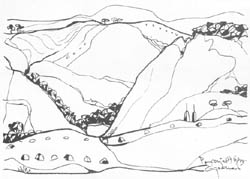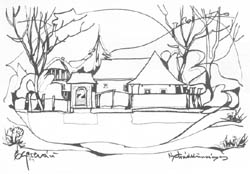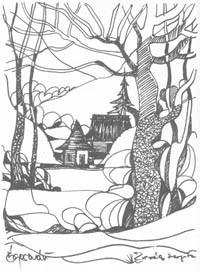ABOUT TRANSYLVANIA ALSO (AFFECTIONS AND ARTWORK OF IMRE ÉGERHÁZI)
Imre Égerházi has been drawing and painting the landscapes of Transylvania for 35 years. Only the famous master was born in Hajdúhadház and lives in Debrecen. What can trigger your distant attraction? What do his works testify to?
He first traveled in Transylvania as a boy scout in the summer of 1941. They camped around Rév. “Since then, I have been enduring admiration and love for this landscape,” he writes in his memoirs. Perhaps a little exaggerated, but this explanation is credible. The first flares of emotional and spiritual independence make deep imprints of the object of our admirations or detestations.
Sometimes this object itself is dwarfed by the strength and weight of its effect. It happened differently here. Imre Égerházi, the mature man and the conscious artist, wanted to face that strange feeling, now based on experience, on the comparison on the broader basis of self-knowledge. When he could, he traveled to Transylvania. The next time this was possible was in 1956. According to his recollections, “I went to Târgu Mureş, looked around the Somos, made a series of drawings of the Târgu Mureş, and then of the Romanian cemetery and wooden church at the end of Göcsi Máté Street. I also painted in Nyárádköszvényes, Nyárádszerdahely, Sovata, Borszék…” In fact, 35 years have begun with this mature, conscious confrontation.
The attraction itself found more and more sources. It turned out that one of the ancestors of Imre Égerházi, Mihály Egerházi from Bősháza, received a noble diploma and coat of arms from Prince Mihály Apafi in 1670, which bears the slogan “For Art and Homeland”. And this branch is obviously the same as the Egerháza residents of Mezőbánd, who were previously famous for their pictorial craft during the reign of Gábor Bethlen, so a palette and a brush could be included in their coat of arms. The works János and István Képíró Egerházi include, for example, the ceiling decorations of the palace in Gyulafehérvár and the colored cassettes of the Reformed church in Gyulakuta. This is how far Imre Égerházi could venture while researching his own affections. Unnecessarily? In the realm of the soul, nothing is superfluous, which nourishes emotion and mood.
In our case, there was a direct need for this increased internal driving force. Imre Égerházi, as a founding member of the Hajdúság International Artists’ Colony, also took part in the organization: from 1969 he mediated and arranged the invitation of the Transylvanian artists. Today, as the leader of the Hortobágy Creative Camp, he is following the same path. Past and present obstacles are numerous. A large portion of responsibility sits on his shoulders. That is why an ever-renewing inner faith and strength is needed.
Meanwhile, paintings, drawings and engravings also flourished. Imre Égerházi remained loyal to the Transylvanian landscape by showing his changing and eternal traits together. From Bihar to Gyergyó, he collected sketches of almost every characteristic sight in his booklets and folders. However, his finished works summarize the details of the spectacle into a unified system of shapes, colors, and structural members. These surfaces are dominated mainly by the expressive elements of agility and serenity, flexible subtlety, and large proportions. That is, in this method and approach, there is what and what to transform, in quantity and quality unceasingly.
Ágoston Székelyhidi






